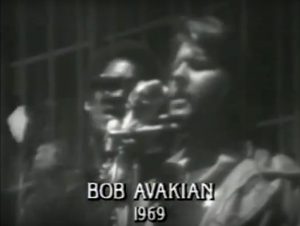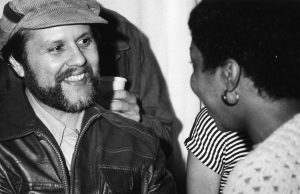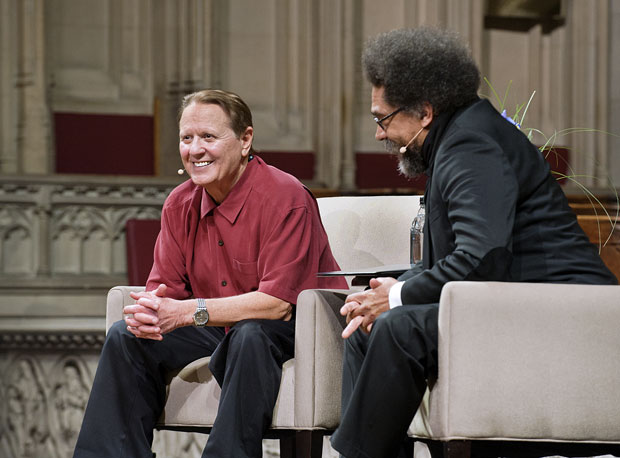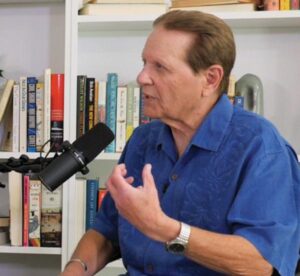FORMATIVE EXPERIENCES, CRITICAL JUNCTURES, DECISIVE LEADERSHIP
GROWING UP IN BERKELEY
Bob Avakian was born in Washington, DC, and grew up in Berkeley, California. His father, Spurgeon "Sparky" Avakian, the son of Armenian immigrants, was a lawyer and then an Alameda County judge in Oakland, California and a member of the Berkeley School Board. His mother, Ruth, was a teacher.
In his memoir, From Ike to Mao and Beyond: My Journey from Mainstream America to Revolutionary Communist, BA talks about how, as a young person, he had passion for music, sports, poetry and literature, and these intersected with his life growing up in the 1950s and ’60s in Berkeley, a university town with a racially diverse population, which would become a center of intellectual, cultural and political ferment that would have a major impact on the whole country. Growing up and going to school with Black friends, singing in doo-wop groups and playing sports, Avakian experienced up close and personal the prevailing segregation and racism in society and the ways it affected his Black friends. As a young person, Avakian came to hate racism and would brook no tolerance for white people who were racist or did not uncompromisingly oppose racism. He was the quarterback of his high school football team at Berkeley High. In his memoir he recounts the experience of a late night bus ride after a game:
On the way back after the game I was sitting with some Black friends of mine on the football team, and we got into this whole deep conversation about why is there so much racism in this country, why is there so much prejudice and where does it come from, and can it ever change, and how could it change? This was mainly them talking and me listening. And I remember that very, very deeply—I learned a lot more in that one hour than I learned in hours of classroom time, even from some of the better teachers.
His early passion for sports in general, but especially basketball, could have led his life in an entirely different direction. As he explains in his memoir:
I always thought that if I hadn’t ended up being a communist, maybe I would have been a high school basketball coach—but I was feeling that my life should be about something more than sports, as much as I still had real passion about that. I felt that there were so many big things going on in the world, I wanted to do something with my life that would mean something or, to use the phrase of the time, be relevant and not just be a personal passion for me.
Even in high school, along with his passion for sports, BA was drawn to intellectual discovery and exploration. In his memoir he speaks to part of the process which led to his not believing in the existence of god:
Getting into philosophy, starting to study history as well as literature, and so on—led me to see from a lot of different directions that religion and the idea of god were human inventions. All these different cultures had different ideas of god that conflicted with and contradicted each other. We studied Greek mythology with Ms. Bentley and you could see that different people in different ages believed in all different kinds of gods, and that some of these had passed out of convention and weren’t widely believed in any more....
As for my friends, today there’s all this nonsense about how Black people are just inherently religious—and that’s a whole thing that gets me pissed off, it’s just bullshit. These are socially conditioned things. A lot of my Black friends and a lot of people who influenced me later in life, like the Panthers, were going through the same thing I’d gone through, and recognized that these religious ideas and institutions are human inventions—and not very good ones. So some of my friends were still religious, but many of them were going through the same general kind of emancipating experience that I was in casting off religion.
BA entered the University of California, Berkeley in the fall of 1961, intending to pursue a wide range of academic interests and try out for the freshman football team, but that plan was cut short by a life-threatening illness that required months of hospitalization and years of intensive treatment.
EARLY POLITICAL LIFE
Even as he was recovering from his illness and beginning to recover his energy, BA resumed his studies at UC Berkeley. His entrance into campus life coincided with an important point in U.S. history where Berkeley was leading the way in cracking open the conservatism of the 1950s, as students broke out in social protest and intellectual challenges to the status quo—most notably expressed in the early ’60s by the Free Speech Movement. This movement challenged the university’s ban of campus organizing around off-campus issues, in particular students protesting against the racial discrimination in hiring as was being practiced by local businesses. Avakian became an active participant in the Free Speech Movement from its beginning stages in September 1964. He was one of the 800 arrested in the mass sit-in in the campus administration building, which was the decisive turning point for the Free Speech Movement in winning its demands.
These were times when people across the country were waking up, challenging “the way things are” in all aspects of U.S. society, going up against the culture, institutions, and political rule of the system—and BA was in the midst of all of this as a strategist and organizer, a writer and speaker, and he was putting his body on the front lines of resistance to the crimes of U.S. imperialism.
From early on, Avakian was active in the Vietnam Day Committee (VDC), which organized some of the earliest teach-ins and demonstrations in the U.S. against the Vietnam War, beginning in 1965.
In 1967, BA was one of the originators and organizers of Stop the Draft Week, which aimed to raise the level of resistance to the Vietnam War by staging sit-ins to shut down the Army Induction Center in Oakland, California. This led to a massive and brutal police assault on the demonstrators, which gave rise to street fighting as the protesters defended themselves against repeated police attacks.
Avakian worked as a researcher and writer for Ramparts magazine, contributing many articles opposing the Vietnam War and racism and in support of Black power. BA was instrumental in arranging for the article in Ramparts featuring Donald Duncan, a sergeant in the U.S. Army who was one of the first U.S. soldiers to turn against and publicly denounce the Vietnam War. BA continued, over the following years, to carry out discussion and struggle to convince soldiers and veterans of the U.S. military to come out in opposition to the Vietnam War; and he actively organized to build support for them in doing so.
In the late ’60s, out of the civil rights movement there emerged a more radical struggle for Black Liberation. BA began working closely with the Black Panther Party for Self-Defense (which later became the Black Panther Party), from its early days when it consisted of Huey Newton, Bobby Seale, Eldridge Cleaver, Bobby Hutton and a small number of others. Beginning in the latter part of 1967, BA worked tirelessly to organize political defense and support for Huey Newton, who was arrested and charged with murder as a result of a shoot-out in Oakland in which Newton was wounded and a policeman was killed.
Toward the end of 1967, people in California—outraged over the Vietnam War and U.S. foreign policy overall, as well as the savage inequalities within U.S. society itself—launched a petition campaign to put the Peace and Freedom Party on the ballot for the 1968 elections, as a radical alternative to the Democratic as well as the Republican Party. At the urging of Eldridge Cleaver, BA joined with these efforts—going on a tour across California (together with members of the San Francisco Mime Troupe and the newly emerging band Santana) which played a significant part in rallying the necessary numbers of people to get the Peace and Freedom Party on the ballot. During the course of this tour, BA was arrested twice: once as a result of an impromptu protest against ROTC at a high school in Los Angeles; and another time while joining in an antiwar rally at San Jose State that was violently attacked by the police. BA was instrumental in convincing the Peace and Freedom Party to align itself with the Black Panther Party and to take up the defense of Huey Newton. By the summer of 1968, the Peace and Freedom Party had developed as a national party, and BA played a major role in the successful effort to have Eldridge Cleaver nominated as its presidential candidate.
THE JOURNEY TO BECOMING A COMMUNIST—AND A COMMUNIST LEADER
By the end of 1967, Avakian had moved to Richmond, California, in order to take revolutionary politics—including, as a key part of that, support for the Black Panther Party and the fight against racism—to poor whites and other poor people in that city, while continuing to be active organizing in the student movement and in the community against the Vietnam War.
It was in this period that BA and others began to more seriously study some of the “classics” of Marxism, including the writings of Mao, as part of engaging and exploring a theoretical framework for their developing revolutionary inclinations. This study, along with the debates and ferment of the times, led him to view Marxism as the theoretical framework that most scientifically synthesized an understanding of the dynamic underpinnings of the capitalist-imperialist system and why it continually gives rise to exploitation and oppression in many forms.
In 1968 Avakian played a central role in uniting a number of revolutionary collectives into the Bay Area Revolutionary Union, with the view that this would be one organization among many (such as the Black Panther Party as well as other organizations and collectives) which at some point would build ideological and political unity as the basis for a new multi-national communist party.
In the summer of 1970, BA was part of a group of leading members of the Bay Area Revolutionary Union who traveled from its founding base in the Bay Area across the U.S. to reach out to and carry out investigation, discussion and struggle with collectives throughout the country. Through this process, in which BA played a decisive role, the Bay Area Revolutionary Union developed as a national organization in 1970 and changed its name to the Revolutionary Union (RU). BA was elected as a member of the Central Committee of the national RU and was increasingly recognized as its leading member.
Into the 1970s, various revolutionary collectives and organizations continued to develop their positions on important questions related to revolution and communism, questions such as: If you are going to be for revolution, what are the objectives of such a revolution? How can you make that revolution? What kind of leadership do you need? What should be your program? What forces do you need to mobilize and unite for revolution?
During the period of 1968-1974, BA wrote much of Red Papers (1-7), the journal of the Revolutionary Union, including major theoretical articles and polemics in Red Papers 4, 5, and 6. Through his writings in Red Papers, Avakian began to develop a scientific method and approach from which he explored a number of critical questions related to summing up the experience of the world communist movement, as well as speaking to the big and contended political and ideological issues of the day, in many different dimensions, including the fundamental question concerning the nature of the Soviet Union—whether it was still a socialist country, or whether (as Avakian argued) Mao’s analysis was correct, that capitalism had been restored there. Avakian continued to focus attention on the theoretical and practical problems of uprooting the oppression of Black people in the U.S. and to emphasize the crucial relation of this to the overall strategy for revolution. As he later stated:
There will never be a revolutionary movement in this country that doesn’t fully unleash and give expression to the sometimes openly expressed, sometimes expressed in partial ways, sometimes expressed in wrong ways, but deeply, deeply felt desire to be rid of these long centuries of oppression [of Black people]. There’s never gonna be a revolution in this country, and there never should be, that doesn’t make that one key foundation of what it’s all about.
During this same period, Avakian was actively involved in building support for striking oil workers in Richmond and in forging links between those striking workers and movements of students, including “Third World” student strikes on the campuses of San Francisco State and UC Berkeley. During the oil workers’ strike, BA was arrested as a result of a confrontation with company “goons” who attacked the workers’ picket lines and were attempting to break the strike.
BA led the Revolutionary Union in relating to the struggle in Berkeley around People’s Park and took part in a number of demonstrations that were part of resisting the imposition of virtual martial law in the city of Berkeley in the context of this struggle.

BA continued to be involved in the movement against the Vietnam War and in support of the liberation of Black people, Chicanos and other oppressed nationalities. He spoke at a rally of thousands in San Francisco, sponsored by the Black Panther Party, on May Day 1969. Later that year—a year in which police murdered Fred Hampton, head of the Chicago Chapter of the Black Panther Party, and waged massive armed assaults on the Black Panther Party and its offices in a number of cities—BA was instrumental in organizing a squad of people to join with others to defend and help prevent an attack on the Black Panther Party’s national office.
BA played an active role in national conventions of SDS (Students for a Democratic Society) in the spring and summer of 1969, where he put forward the position of the Revolutionary Union on revolution and the role of students and youth, and upheld the struggles of Black people, Chicanos, and other oppressed peoples within the U.S.—engaging in sharp struggle with representatives of various opportunist trends.
As one of the main leaders of the Revolutionary Union, BA played a key role in reviving the celebration of International Women’s Day as a revolutionary holiday in the U.S. During the course of the 1970s, BA was a featured speaker in IWD rallies and demonstrations in many different cities. In his memoir BA speaks to various influences of the time that led him to more deeply understand the essential relationship of the oppression of women to revolution:
I think what was most essential within all this was a communist understanding of the oppression of women and the pivotal role this played in the development of class divisions and oppressive society overall, on the one hand; and, on the other hand, the pivotal role that abolishing all that and completely emancipating women played in the overall struggle to end all oppression and establish a society, a world, without class divisions and without oppressive relations.
When a split occurred in the Revolutionary Union, as a result of some of its members in the Bay Area adopting a line of infantile posturing and acts, which would have led to the destruction of the RU and a serious setback for the revolutionary movement, BA led the struggle against this and rallied the majority of the RU to the fundamentally correct line of approaching revolution in a serious and scientific way, with the orientation that the communist revolution that is needed to seize power and build a new society must not be the act of a small number of radicals divorced from the masses of people but must ultimately involve millions of people in order to have a possibility of defeating the repressive force of the existing system and its state power.
In this period, May Day, historically celebrated internationally as a revolutionary holiday, was revived in the U.S. by the Revolutionary Union under BA’s leadership, and BA spoke at a number of May Day rallies, in various cities in the U.S., over the course of the 1970s.
In the fall of 1971, BA headed a delegation to then socialist China, where he gained a deepened understanding of the achievements in building socialism there and what the character and goals were of the Cultural Revolution in China and engaged in discussion about the communist movement historically and internationally.
BA visited China again in the latter part of 1974, when the Cultural Revolution was intensifying, in what became the last great battle of Mao and those who were fighting for the revolutionary line that Mao represented against the revisionists within the Chinese Communist Party—communists in name who were in fact seeking to restore capitalism in China and were gaining strength within the Party, and who were finally able to seize power and brutally repress the revolutionary forces after Mao’s death in 1976. During this 1974 visit to China, BA engaged in lively discussion and struggle with various representatives of the Chinese Communist Party about the continuation of the revolution within socialist society and the relation between that and the international role and revolutionary responsibilities of a socialist state such as China.
THE STRUGGLE TO BUILD THE REVOLUTIONARY COMMUNIST PARTY, USA
During the first half of the 1970s, a protracted process of theoretical debate and ideological struggle was carried out broadly among forces that had come forward through the upsurge of the 1960s and were grappling with the question of how to carry forward the revolutionary impulse of that time and give it an ongoing organized expression. Theoretical debate, at times heated, was waged around the critical issues of what kind of revolution is needed, issues of revolutionary strategy, and very closely linked to these issues, the question of what comprises revolutionary leadership. Through this period of intense and complex theoretical debate and ideological struggle, Avakian played a key role in the development of a new communist party in the U.S.
Avakian led a struggle within the Revolutionary Union (RU)—which also involved a split between the RU on the one side and the Black Workers Congress and the Puerto Rican Revolutionary Workers Organization (formerly the Young Lords Party) on the other—over the theoretical and political basis of the new revolutionary party that needed to be formed. The split centered on whether this new party should be based on what amounted to nationalism and suffocating dogmatism or whether, as Avakian insisted, it must be based on internationalism and an orientation and application of living scientific communism. This struggle resulted in a deepening of the scientific foundation of the RU overall, but secondarily was also accompanied by developing tendencies within the RU toward economism—toward reducing the work of communists to merely being the best fighters for the day-to-day economic struggle of the workers, rather than representatives of the fundamental revolutionary interests of the proletariat, in striving for the end to all exploitation and oppression throughout the world.
BA went on a national speaking tour in 1974 to help strengthen the basis for the formation of the new, revolutionary communist party that the Revolutionary Union was working to bring into being.
In 1975, the Revolutionary Communist Party, USA (RCP, USA) was formed. At its founding congress, BA was elected chairman of its leading body, the Party’s Central Committee. He has continued to hold this position to this day.
Avakian’s role as a revolutionary leader did not go unnoticed by the powers that be. In the early 1970s, a top FBI official noted to subordinates that “This is the kind of extremist I want to go after HARD and with innovation.” In fact, FBI surveillance files from 1975 detail, minute by minute, the movements of Avakian and his associates, and include drawings of his residence.
RESTORATION OF CAPITALISM IN CHINA
In 1976, shortly after the death of Mao, Mao’s closest circle (known as the “Gang of Four”) were arrested and denounced by those in the Chinese Communist Party, headed ultimately by Deng Xiaoping, who were determined to take China down a counterrevolutionary path—the path to capitalism. This was in fact a major crossroads in the international communist movement, posing an historic challenge to revolutionaries around the world who had looked to Mao and socialist China as an inspiration. Among communist parties and forces worldwide, there developed profoundly different understandings of what had happened in China.
Within the RCP, USA, different positions emerged within the leadership over what was represented by the overthrow of the “Gang of Four” and the coming to power of the camp led by Deng Xiaoping.
Stepping back, BA recognized that this was an important turning point not only for the RCP but for the international communist movement. He felt compelled to develop an approach and method to systematically and scientifically study and analyze these critical events in China and their world-historic and worldwide impact and importance—a process that was carried out over the course of a year.
At the same time, he was developing principled means to deal with the resistance and organizational sabotage of those within the RCP who were working to undermine this approach and to use factional means to gain support for their position of supporting the revisionist coup in China and fighting for an economist/revisionist line within the RCP itself.
The issue came to a head in a meeting of the RCP’s Central Committee, where a majority of the leadership, led by Avakian, came to the conclusion that what happened in China was a coup that overthrew socialism and was in the process of unleashing capitalism in China. This led to a major split in the RCP with a significant minority who supported the new leaders in China leaving the Party, and before long giving up all pretense of being communists and working for revolution.
On the basis of the clarity that had been achieved, through this struggle within the RCP about the monumental events in China, and the opposition between revolutionary communism and revisionism overall, the RCP organized the Mao Tsetung Memorials, on the East Coast and on the West Coast, to share these lessons with a broader public. At these Memorials, each of which was attended by more than a thousand people, BA gave the historic speech, “The Loss in China and the Revolutionary Legacy of Mao Tsetung.”
GOVERNMENT ATTACKS AGAINST BA; GOING INTO EXILE
In January 1979, a demonstration was held in Washington, DC on the occasion of Chinese leader Deng Xiaoping’s visit to the U.S. for a meeting with then U.S. President Jimmy Carter. Deng Xiaoping was the leader of the process of overthrowing socialism and restoring capitalism in China. The RCP organized a demonstration in Washington, DC in opposition to this, denouncing and exposing what was represented by Deng Xiaoping and his meeting with Carter. This demonstration was viciously attacked by the police, seriously injuring some of the 500 demonstrators and arresting dozens, including Avakian. The authorities in DC ended up charging BA and about a dozen others with multiple felonies that carried a maximum sentence of 241 years.

In response, the RCP rallied hundreds of supporters to go to DC itself and organized political support around the country for what came to be known as the Mao Tsetung Defendants. In connection with this, BA went on a speaking tour in a number of major cities across the U.S. that reached thousands of people.
Owing to the political support that was rallied, and to the work of the legal team representing the Mao Tsetung Defendants, the charges against BA and the other Mao Tsetung Defendants were temporarily dismissed, although it was clear that the government could, and very possibly would, work to reinstate these charges. At the same time, in connection with BA’s appearance in Los Angeles as part of his national speaking tour, an article appeared in the Los Angeles Times which distorted things to make it seem that BA had threatened the president of the United States. Even though the Los Angeles Times was forced to print a partial retraction, agents of the Secret Service came to BA’s residence seeking to “question” him about this alleged threat to President Carter.
In 1980, the RCP faced many arrests and other repression. Damián García, who was closely associated with the RCP and who was known for having raised a red flag on top of the Alamo a few weeks earlier as part of building for RCP-sponsored demonstrations on May Day 1980, was murdered in Los Angeles. In this same period there were growing reports of death threats against Avakian from various quarters.
Noting the developing pattern of repression directed against BA—and looking at this in light of the historical experience of how the ruling class of the U.S. and its state has dealt with revolutionaries (such as the political assassinations of revolutionaries like Malcolm X and Black Panther Party leader Fred Hampton) and even dissidents who represent serious opposition—the decision was made that BA should leave the U.S. in order to disrupt what were clearly mounting attempts by the powers that be to move against him. In 1981, BA applied for political refugee status in France. During this period, the charges against the Mao Tsetung Defendants, including BA, were in fact reinstated. BA’s application for political refugee status was denied—this application had been a definite embarrassment not only to the U.S. imperialists and their posture as the world’s greatest democracy and “leader of the free world,” but also to the French and UN authorities, who try to act as if there is not, and could not possibly be, political repression in a country like the U.S.
Only through a continuing campaign to rally political support, along with fighting this in the legal arena, was a successful resolution achieved in the case of the Mao Tsetung Defendants, with no defendants having to serve jail time and all the charges against BA completely dropped.
CONTINUING LEADERSHIP OF BOB AVAKIAN
Over the course of the several decades since then, in spite of the difficulties of his situation, and whatever his particular circumstances have been, BA has continued to provide crucial leadership to the RCP, as its chairman, and to wage continuing struggle for not only the RCP but the international communist movement as a whole to be firmly based on a systematic scientific method and approach to the many crucial dimensions of the struggle to radically transform the world toward the goal of communism. In the theoretical realm, he has continued to make breakthroughs and to further deepen and develop the new synthesis of communism.
The breadth and depth of such revolutionary leadership is very complex and nuanced, carried out on a number of levels. This is spoken to in depth by Avakian in THE NEW COMMUNISM—The science, the strategy, the leadership for an actual revolution, and a radically new society on the road to real emancipation and by Ardea Skybreak, in SCIENCE AND REVOLUTION: On the Importance of Science and the Application of Science to Society, the New Synthesis of Communism and the Leadership of Bob Avakian (a wide-ranging interview with Skybreak conducted by Revolution newspaper).
In describing the leadership of BA, Skybreak makes the point:
When it comes to leading the revolution, BA is both a very developed and visionary theoretician and a very sharp and experienced down-on-the-ground practical leader. He is very much both things—that’s the point I am trying to get across. And yes, that combination really is very rare, and it is also very important, and very precious.
Again, this is something I think people often don’t understand—that if you’re the leader of a revolutionary party and you are a key leading theoretician who is bringing into being a new theoretical framework for the revolutionary process and for the building of a new society, that doesn’t mean you’re just kind of “out in the clouds” somewhere with some abstract thinking, even some good abstract thinking, but without any connection to the development in practice of the day-to-day struggles. Quite the contrary. My understanding as a scientist of the process involved, and what is evident in BA’s writings, which I do study carefully, is that he is very, very much integrally involved in every aspect of the development of the revolutionary movement of today on all these key fronts. These are not fronts that are being led just by other people. There are of course other leading people who are taking on very important and critical responsibilities vis-à-vis these fronts, but they are not doing this in isolation and separately from the leadership, the overall strategic leadership, that is being provided by BA and by the central leadership of the RCP to all of it, to the entire ensemble of work in this period.
The overall approach to this is captured in the formulation “Fight the Power, and Transform the People, for Revolution.” This involves mobilizing people to fight around the “5 Stops,” key fault line contradictions of this system—the oppression of people of color; of women and of LGBT people; the persecution of immigrants; wars of empire, armies of occupation and crimes against humanity; and the devastation of the environment by capitalism-imperialism—and to do all this in such a way as to build for the revolution that is needed to ultimately put an end to all this unnecessary suffering and destruction.
Cultural Revolution within the RCP
In 2003, Bob Avakian initiated and led a Cultural Revolution right within the Revolutionary Communist Party, as a means and method for dealing with seriously revisionist lines and tendencies that were threatening to take the Party fundamentally off track, in the direction of economism, reformism and accommodation to the imperialist system. “Revisionism” is phony communism that cuts out or revises the revolutionary heart of communism, and whose actual program and method is limited to trying to reform the existing system of capitalism-imperialism.
This took place in the context of a world situation marked by serious setbacks for the communist revolution and the remaining, and in some ways heightened, power of imperialism, and in particular the continuing effects of the reversal of the revolution and the restoration of capitalism in China (as well as the fact that what had been the revisionist Soviet Union, and states aligned with it, had broken down into a number of openly capitalist states).
Recognizing the very real danger that the RCP could be transformed from a revolutionary party into a revisionist shell, betraying the masses of people for whom communist revolution is the only way forward out of their desperate conditions of oppression and exploitation and the only hope for dealing with the looming destruction of the environment—BA launched the Cultural Revolution within the RCP, with the aim of achieving a radical reconstitution and strengthening of the Party as a force worthy of the name of Revolutionary... Communist... Party and capable of acting as a vanguard force of the communist revolution that corresponds to the fundamental interests of the masses of oppressed people, and ultimately humanity as a whole. This Cultural Revolution has prevented the triumph of revisionism within the RCP, and it is continuing to further uproot revisionist influences and strengthen the revolutionary communist character and vanguard role of the Party.
To this day, through his talks and writings, and his overall political, ideological, and methodological leadership, Bob Avakian has continued to guide the RCP, USA in its fundamental orientation and strategic approach of working for revolution in the U.S. itself and contributing all it can to revolution and the ultimate goal of communism in the world as a whole.
Public Appearances
Since around 2003 BA has made several public and semi-public appearances.
In 2003, a film was released of a talk BA had given to audiences in New York City and Los Angeles, Revolution: Why It's Necessary, Why It's Possible, What It's All About, a film of a talk by Bob Avakian.
In the fall of 2012, Bob Avakian gave a series of talks in different cities. Out of this came the film, BA Speaks: REVOLUTION—NOTHING LESS! Bob Avakian Live.

On November 15, 2014, 1900 people witnessed an historic dialogue at Riverside Church in New York City between Cornel West and Bob Avakian entitled Revolution and Religion: The Fight for Emancipation and the Role of Religion. Taking place in the charged atmosphere of upsurges breaking out around the country in response to the police murders of Michael Brown and Eric Garner, this Dialogue brought out people from all sections of society, from Ferguson, Missouri to Hawai‘i, and was viewed via simulcast in cities throughout the U.S. as well as in Mexico and Europe.
In October, 2017, at a crucial point in time when the Trump/Pence regime was attempting to consolidate fascism, a film was released of a talk by Bob Avakian titled:
THE TRUMP/PENCE REGIME MUST GO!
In The Name of Humanity
We REFUSE To Accept a Fascist America
A Better World Is Possible
In the summer of 2018, Bob Avakian gave a two-part speech in New York and Los Angeles, Why We Need an Actual Revolution and How We Can Really Make Revolution. This was followed by a Q&A in both cities. The video and text can be found here.
In the fall of 2022, The RNL—Revolution, Nothing Less!—Show on YouTube conducted an extensive wide ranging three-part interview with Bob Avakian titled The Bob Avakian Interviews: Up Close and Personal with Bob Avakian, Heart and Soul & Hard-Core for Revolution.
Body of Work
The scope and content of BA’s leadership is reflected in his extensive body of work which includes more than a hundred articles, books, films and audio recordings. BA’s collected works are available at at www.revcom.us/avakian and through The Bob Avakian Institute, TheBobAvakianInstitute.org.
For more information about Bob Avakian’s life, see his autobiography:
Avakian, Bob. From Ike to Mao and Beyond: My Journey from Mainstream America to Revolutionary Communist, A Memoir by Bob Avakian (Chicago: Insight Press, 2005).
<< Return to Bob Avakian (BA)—Official Biography—Home




